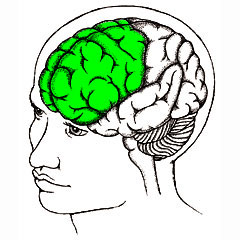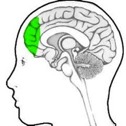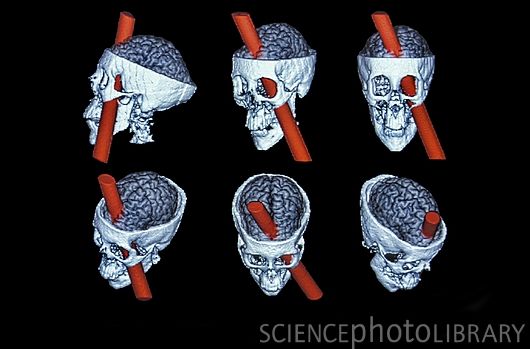The Frontal Lobe!
High functioning animals on this earth have large frontal lobes. The foremost area of the frontal lobe is the prefrontal cortex, or PFC (see lower right). The human brain’s PFC is proportionally largest among all other animals and it is what makes us very different from all other animals. It is what makes us "human".
What does it mean to be "human"?
The PFC is often called the executive of the brain as it is where complex planning and thinking occurs. It may be the reason we have our so-called consciousness, although we must concede that the term is a metaphor for an idea this is ill-defined. It seem to be where our human-like focus lies (Geday & Gjedde, 2009).
Ego and personality are also metaphors for what makes us human, and our capability of contemplating what those metaphors represent, somehow ironically, comes from the possession of our PFC. As proof of this, damage to the PFC can severely alter human personality. Phineas Gage is perhaps the most famous of such cases. Gage was a kind and hard-working man until an steel rod accidentally damaged his frontal lobes in an explosion, turning him into a lazy and unfriendly person (see below) .
Being the newest section of the brain, evolutionarily speaking, the frontal lobe is one of the slowest areas to develop. This easily explains why children and even adolescents are ‘less adult-like’ when trying to make rational, executive decisions; children make more animalistic with "from-the-gut choices" because their frontal lobes take at least 25 years to fully develop (Dosenbach et al, 2010; Fischer, 2008). Biological development that directly relates to cognitive development will be discussed in detail in the Dynamic Skill Theory section (Fischer).
What does it mean to be "human"?
The PFC is often called the executive of the brain as it is where complex planning and thinking occurs. It may be the reason we have our so-called consciousness, although we must concede that the term is a metaphor for an idea this is ill-defined. It seem to be where our human-like focus lies (Geday & Gjedde, 2009).
Ego and personality are also metaphors for what makes us human, and our capability of contemplating what those metaphors represent, somehow ironically, comes from the possession of our PFC. As proof of this, damage to the PFC can severely alter human personality. Phineas Gage is perhaps the most famous of such cases. Gage was a kind and hard-working man until an steel rod accidentally damaged his frontal lobes in an explosion, turning him into a lazy and unfriendly person (see below) .
Being the newest section of the brain, evolutionarily speaking, the frontal lobe is one of the slowest areas to develop. This easily explains why children and even adolescents are ‘less adult-like’ when trying to make rational, executive decisions; children make more animalistic with "from-the-gut choices" because their frontal lobes take at least 25 years to fully develop (Dosenbach et al, 2010; Fischer, 2008). Biological development that directly relates to cognitive development will be discussed in detail in the Dynamic Skill Theory section (Fischer).
Frontal Lobe (below)

The PFC (below)


The rod trajectory that destroyed a significant portion of Phineas Gage's PFC.
